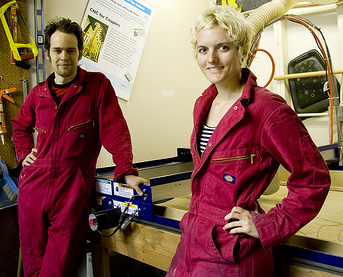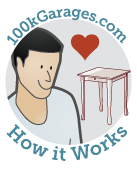Digital fab: the new way for almost anyone to get almost anything made
Digital fabrication is based on having a digital (computer) model of something you want made and then using a digital fabrication tool to make it (digital model > digital production). Digital models are amazing to work with because they allow you to share the exact details of something you would like made with a shop up the street or on the other side of the world. Once given a digital model, a digital fabrication tool can reproduce it reliably and in high fidelity, whether you want one piece or a thousand.
The tools of digital fabrication are pretty amazing
Like a sculptor, digital fabrication tools work either by subtracting material (CNC and laser cutting) or by adding material (3D printing). They can cut, machine, carve, shape, and build thing up in ways that most of us could never do manually ... and they'll do it over and over again with high precision if you want them to. They basically print the real parts of your project in 3D, exactly as specified in your model.
The democratization of digital fab
Jeffrey McGrew, Principal, Because We Can

Read his blog post, about how powerful, affordable, disruptive technology — in Jeffrey's case, a ShopBot Tool — allowed him to create his own business.
Digital fabrication tools were once so expensive that they were only used industrially and often only to make things in large volumes, and they were thought of as automation equipment. But the technology has been democratized by lower priced equipment and software that is oriented to small shops and distributed and collaborative work. We have recognized that more than automated machining these tools express the digital representation of objects in our world. Indeed, it is an emerging digital technology that makes it possible to do custom and distributed production in garages and small workshops around the world, revolutionizing how we make things and manufacture.
By its nature, small-shop digital fabrication embraces ecological and environmental responsibility that emphasize use of local and community materials, products, and services to minimize the energy impact of long distance transportation, while still allowing content and products that can be widely shared. Local networks of collaborating digital fabricators — "local fab" — offers a compelling model for community-based micro-enterprise and distributed production, suggesting how new jobs with attractive life styles can be returned to our communities.
The Star Trek ‘Replicator’ vs 100kGarages
Nearly everyone’s meme for digital fabrication is the Star Trek ‘Replicator.’ The futuristic Replicator has the friendly format of a large toaster oven ready to manufacture anything needed by a crewmember. Someday, we’ll get there, but unfortunately digital fabrication is not quite that easy today. Getting that digital model created and putting the fabrication tools to work to make good stuff can be a challenge. That's where 100kGarages comes in.
We help you make the connections to get your thoughts turned into things.
We are here as a community to help provide resources to turn your ideas into digital designs — and then help you find and collaborate with a Fabber who's well suited to helping you make your particular project.
For working on your design, we have a lot of resource for you via 100kGarages:
- Software resources so you can do the design work yourself
- Search for design help from Designers ready to consult or do custom work
- Get inspired! Visit the gallery of designs for ideas, and find links to downloadable free and for-sale designs
- You can ask questions on the forum about designs, materials, and fabrication techniques
If you are new to digital fabrication, we think you’ll find plenty of information on how the process works. A design is where it all starts…
For producing your project, you can:
- Post your project on the board and let interested Fabbers (or designers) find you
- Or you can use the search functions to find a Fabber specializing in the kind of work you would like to do, or one who is conveniently located.
Convenience is defined by you: it can be someone local to you, or nearby to a potential customer for your work, across the country.
If you have questions about how it will all work, you can send them to specific Fabbers or post them on the forum. Everyone enjoys seeing and hearing about your ideas and projects, but if you have a “secret development project,” don’t worry, you can elect to handle all communications privately. Designers and Fabbers participating in 100kGarages have all committed to an absolute protection of everyone’s intellectual and creative property.
In the Spotlight
The Project Board
A snapshot of current activity
- R8 Paddle 3P...Open for Bidding
- BBQ Smoker Parts...Open for Bidding
- Home DJ Booth...Open for Bidding
- Spindle...Open for Bidding
- Auraclones 25...Delivered




